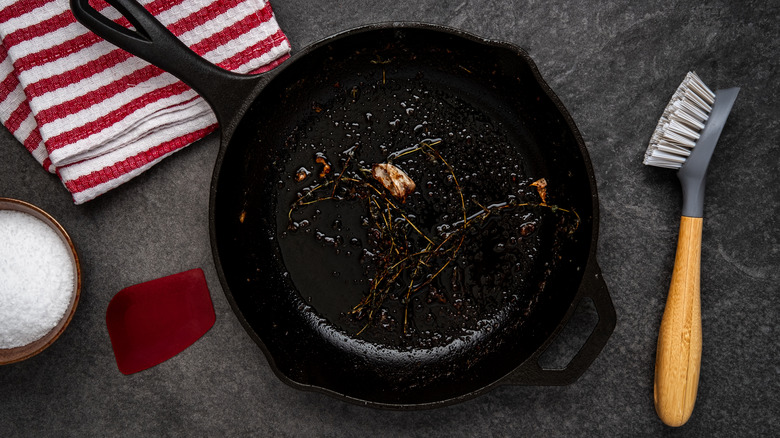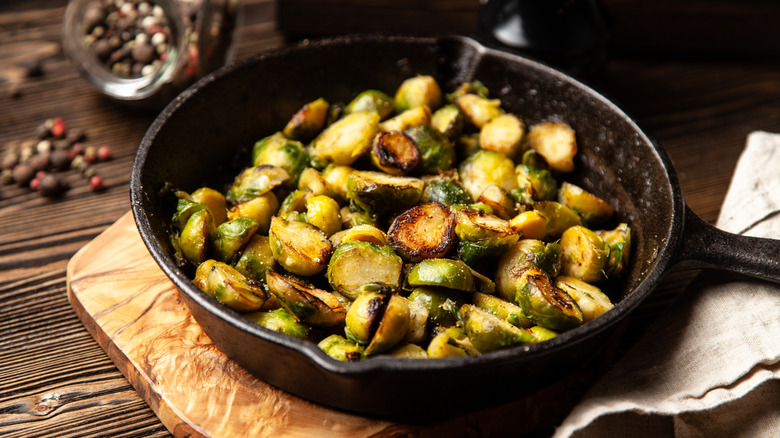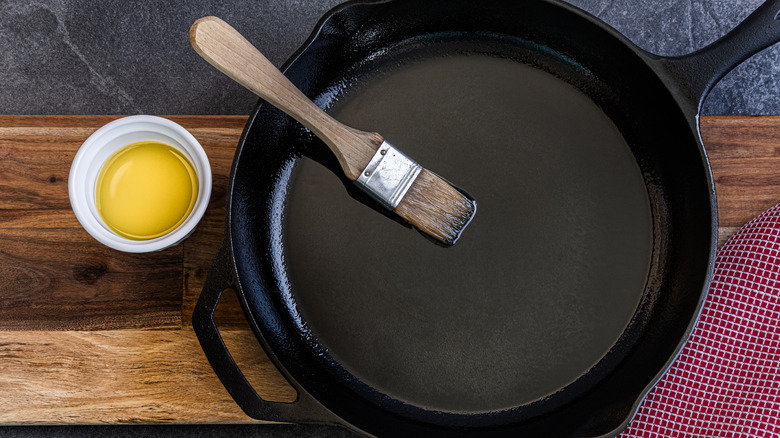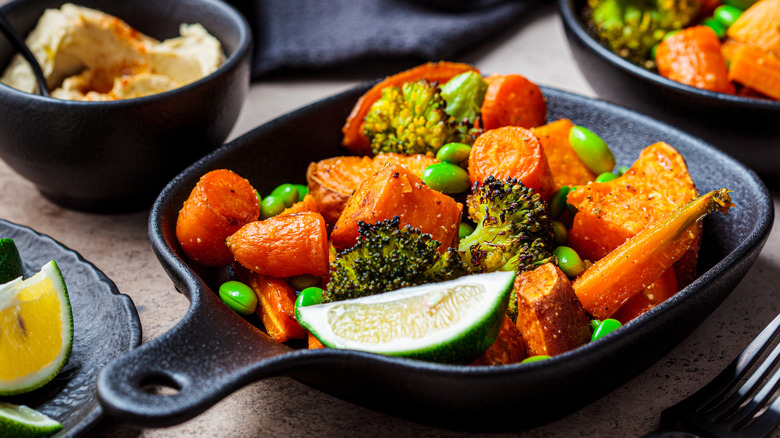12 Foods You Might Want To Keep Away From Your Cast Iron Skillet
Let's be honest — cooking with the great kitchen investment that is cast iron can be a little bit intimidating. There are so many supposed rules that you have to follow in order to not totally warp or ruin cast iron cookware. You've likely heard the big ones. Don't wash it with soap. Don't let it soak overnight. Don't use it every day. Don't scrub it with your normal pot scrubber. Turns out, though, there are seemingly just as many misconceptions surrounding cast iron as there are rules to follow when using your cast iron.
One big misconception is that you shouldn't cook certain foods in your cast iron skillet. While that's true to a degree, it's only partially true. There are tons of caveats and "buts" when it comes to cooking various "no-no" foods in your cast iron skillets and other cookware. Most of the foods that your friend or mother told you not to cook in your cast iron are entirely fine — so long as you take the right approach. Here are some of the top foods you need to keep far away from your cast iron skillet, but with all of the caveats, so you can keep eating what you love, but also keep your cast iron working beautifully and your food tasting great.
1. Tomatoes
When it comes to recommendations as to what not to cook in your cast iron, tomatoes often sit at the top of the list. As HuffPost reports, foods that are high in acidity are notoriously bad for cast iron for multiple reasons, including the reaction that can occur between the high acid and the iron, which can both damage the cookware and lend your food a nasty metallic tang. Seeing how tomatoes are a highly-acidic food and they're so common in the average kitchen it's easy to see why they've gotten a bad rap when it comes to cast iron cooking. But is this notoriety deserved?
According to the cast iron experts at American Skillet Co., no. While cooking tomatoes and other high-acid ingredients in cast iron the wrong way can damage it and make your tomatoes taste like iron, if you do it the right way, you'll be totally in the clear. The company recommends only cooking acidic food in your cast iron after it's been well-seasoned. After that point, the cast iron will have enough protective layers built up that no one — tomato nor skillet — will be harmed in the making of your marinara. Just make sure, after a new cast iron skillet is well-seasoned, that you keep it that way.
2. Smelly foods
Have you ever cooked something particularly pungent in your cast iron and then, even after washing and storing your cast iron, once you pull it out for your next use, the odor is still there? Cast iron has a habit of holding onto strong scents and this fact has inspired some to say you should never cook smelly foods, period. However, you can avoid the smell with the right steps and cook all the smelly, stinky, and odorous foods that your heart desires.
Lodge Cast Iron says, if you're smelling a lot of rank odors around your cast iron, it probably means you didn't clean it well in the first place. You can get rid of retained odors by baking the cookware in a hot oven for 15 minutes, or you can spread salt across the cookware and leave it for a day, before rinsing.
You can cook all the smelly foods you want and make your life easier by automatically adding either of these steps to your post-meal clean-up process, rather than wait around to notice a funky smell. Once you start doing so, you'll realize you can cook anything — fish, Brussels sprouts, garlic, whatever — and confidently put your cast iron away at the end of the night, stink-free.
3. Flaky fish
You may have found a way to get around the old rule of not cooking smelly foods in your cast iron, but does that mean you can really cook fish in your cast iron? Some might tell you not to cook flaky fish in your cast iron because it'll simply stick to the pan and ruin your meal, but Martha Stewart has a tip for that.
In order to prevent your fish from sticking to your cast iron pan, you need a very hot cooking surface. Thankfully, cast iron is great at cooking and retaining high heat. Make sure you add enough oil to your pan before you start cooking, and remember to use an oil with a high smoke point. When the oil shimmers, it's a sign to add your fish. From there, don't fiddle with the fish. If you have enough oil in your pan and it's hot enough, your fish will simply release with a fish spatula with no extra effort and no sticking.
4. Sticky foods
Cooking sticky foods in general on cast iron scares a lot of home cooks, and for good reason. If you aren't supposed to scrub away at your cast iron in order to clean it, what do you do if there's a particularly sticky layer of burnt sauce or a baked-on cinnamon roll along your cast iron pan's cooking surface? Are you just out of luck?
Again, while sticky foods can cause problems for your cast iron if you don't handle them the correct way, with the right precautions and steps, you can cook your favorite sticky items with ease. Lodge Cast Iron cautions that you shouldn't cook sticky foods in your cast iron if your piece is new and it hasn't built up those protective layers of seasoning that come over time. Otherwise, though, you should be fine when cooking sticky foods if you cook with the correct amount of fat and keep your cast iron seasoned throughout its lifetime. If you've already incorrectly cooked something particularly sticky on your cast iron, though, and are dealing with a real mess, the site recommends going at it with a pan scraper.
5. Leftover food
We've all been there. You're busy. You've made dinner and gotten it on the table, but there's still so much more you have to do. You don't have time to immediately clean your cast iron, but you don't want to soak it either. Can you just toss that cast iron, food and all, into the fridge, covered with a bit of aluminum foil?
While that might seem like the easiest option, especially if you're planning on reheating the leftovers in the next few days, you shouldn't leave leftover food in your cast iron. This is one of the few times where there is no caveat or "but." You just shouldn't do it.
According to Hunker, there are several reasons why. One, if the pan is still too hot (and cast iron retains heat for an incredibly long time), putting it in the fridge, leftovers and all, can cause any glass in the fridge that the cast iron is touching to crack, or even make the actual cast iron crack. Even if that doesn't happen, the pan might make the air in your fridge warmer than is safe for the rest of your food. Additionally, leaving leftovers in your cast iron can increase the likelihood of food sticking and the moisture in the food can cause rust.
6. Eggs
Eggs are known as one of those sticky foods that you shouldn't cook in your cast iron, unless you want a nice, annoying layer of cooked egg all along your cast iron's cooking surface. However, according to Field Company, you can swap out your non-stick pan for your cast iron next time you cook breakfast at home, so long as you cook your eggs correctly.
As is the case with many foods, you don't want to cook eggs in a brand-new cast iron pan. That's going to end with some gross, stuck-on eggs all over your cast iron. You have to wait to cook eggs until you've used your cast iron enough that it has that shiny, non-stick look that comes from multiple layers of seasoning.
Then, when you do cook eggs in your well-seasoned pan, start with preheating the pan dry, and then adding whatever fat you plan on using, before adding your eggs. Field Company additionally recommends heating the pan on medium for about 10 minutes and then turning the heat to low before you finally throw in the fat and eggs in order to prevent sticking. If things are still too hot and you suspect sticking, take the pan from the stove and then only resume cooking once the cooking process has slowed.
7. Garlic
You might think of garlic as a food you wouldn't want to add to your cast iron cookware simply because it's smelly, but if you just clean your cast iron correctly, you should be able to cook all the garlic you want ... right? Well, as Southern Living points out, there are more reasons why some home cooks avoid tossing minced garlic into their cast iron-cooked home fries or sautéing it in the bottom of a cast iron dutch oven in preparation for a sauce or stew.
Minced garlic doesn't hold up well to high heat — like the super-high heat put off by cast iron — and once garlic burns, it loses its tasty flavor completely. Additionally, minced garlic is rather sticky. So, how can you continue cooking with both your cast iron and your garlic? Southern Living recommends using whole cloves of garlic rather than minced garlic in your cast iron recipes, as well as using ample oil when cooking anything with garlic along with cooking at a lower temperature.
8. Cold food
Just like you shouldn't store leftover food in cast iron cookware, you also shouldn't put cold food directly into your cast iron, like a frozen steak directly onto your hot skillet. This type of sudden, shocking change in temperature can permanently damage your cast iron cookware, causing it to crack or warp, according to Michigan State University Extension. Instead, let cold or frozen foods come to room temperature before adding them to your skillet.
Along the lines of not placing cold food in your cast iron cookware, the Extension also recommends that you take the time to bring your cast iron up to the right cooking temperature gradually. So, if you need to preheat a cast iron skillet in the oven for cornbread, for example, you would want to put the skillet in the oven before you set your oven to preheat, so the two both gradually come to the correct temperature together. Likewise, after you're finished using your cast iron cookware, don't take the hot cookware from the stovetop to the sink and turn on the cold water. Instead, let the cookware cool to room temperature before beginning to clean.
9. The wrong oils
Using oil in your cast iron cookware is very important. Utilizing enough oil as you cook will prevent pesky sticking that's otherwise common when cooking a range of foods, from garlic to eggs. However, the type of oil you use is particularly of note when you're planning to season your cast iron cookware.
If you're trying to re-season cast iron, after damage or inappropriate use, or if it's just been a long time since you've used the cast iron, you'll typically do so by adding a sheen of oil to the cooking surface and then heating the cast iron at a high temperature for a short amount of time. Because re-seasoning is generally done at a high temperature, then, you'll want to only use oils for this process that have a high smoke point. Lodge Cast Iron recommends using canola or vegetable oil as canola oil has a smoking point of 425 degrees Fahrenheit, while vegetable oil has a smoking point of 400 degrees Fahrenheit. On the flip side, you'll generally want to avoid using low-smoke point oils such as flaxseed and coconut oils.
10. Foods with high amounts of oxalate
So, firstly, what's oxalate? According to an article from Washington College, oxalate is found both in humans and plants and is a result of your body (or a plant) processing Vitamin C. While your body can typically take care of oxalate just fine, if there's an increase in oxalate levels, it can cause issues, such as healing impairment of injured tissues and joints, or disease. Lots of foods contain oxalates, or oxalic acid, including blackberries, beets, spinach, and sweet potatoes.
But the health concerns surrounding eating high amounts of oxalates aren't why you should avoid cooking them in your cast iron. Instead, Food Network found that high-oxalate foods, when cooked in cast iron, create a chemical reaction and normally vibrant foods such as beets, rhubarb, and spinach, turn brown. So, for the prettiest foods possible, don't cook high-oxalate food in your cast iron and, maybe, if you're concerned, take a look at how much oxalate you're consuming on a regular basis.
11. Foods high in Vitamin C
You likely know that you need a certain amount of iron in your diet, but unless you have any particular health concerns, you probably don't think about how much iron you're consuming on a daily basis — especially iron you might be inadvertently consuming due to cooking in your cast iron cookware. However, cooking in cast iron can, under the right circumstances, easily and dramatically increase the amount of iron you're getting from your cooked food (via Food Network).
According to Food Network and a study by the Journal of the American Dietetic Association, foods high in Vitamin C are more likely to absorb more iron from cast iron cooking than others, and, in some instances, the Vitamin C-rich foods in the study showed new iron levels that were increased by as much as 7 milligrams after being cooked in cast iron. For reference, the daily recommended amount of iron for an adult male is only 8 milligrams total. So, if you're cooking for someone watching their iron intake or a child (the recommended daily iron intake for children is relatively low), you might want to skip the cast iron.
12. Both savory and sweet items
If anyone's ever told you not to cook desserts in your cast iron, it's likely due to odor and flavor transfer. They could very likely have had a bad experience, wherein they cooked up a steak or other savory dish with unmistakable flavors, then made a pie or skillet cookie the next day, only for their dessert to come out tasting like sirloin. It's definitely something that can happen — but it doesn't have to.
If you want to cook both savory and sweet items in cast iron, cast iron manufacturer Uno Casa recommends having one piece of cast iron cookware dedicated to savory items and one piece dedicated to desserts. Of course, you could also be sure to actually clean your cast iron appropriately before storage, and, if you notice any lingering odors, remove them via a little time in the oven or a sprinkle of salt left to sit overnight.












